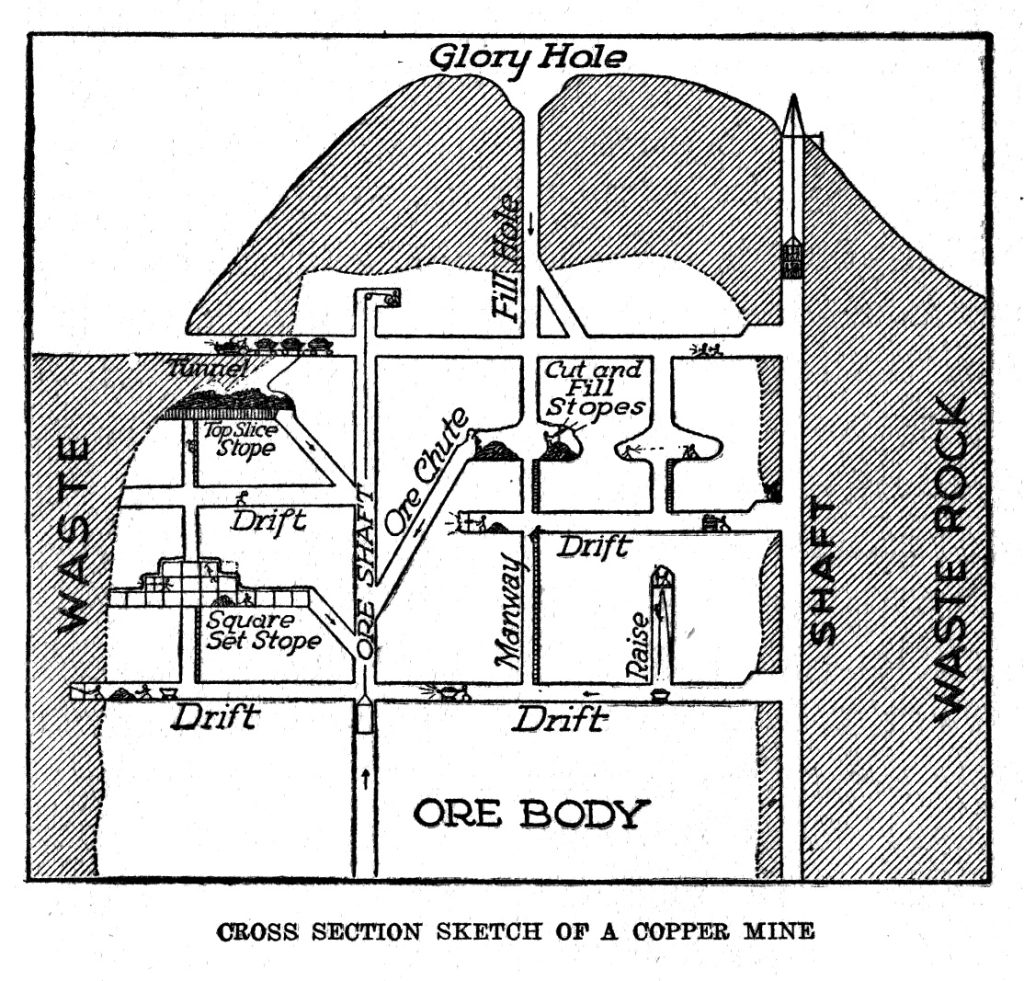
Moctezuma Copper Company Producing At Very Great Rate (1917)
23 de enero de 2023
Unknown Author (1917)
Great Phelps Dodge and Company, located in Sonora, near Nacozari, one of the most modern and most productive of mines in Northern Mexico—Mines located seven miles from big concentrator site.
The property of the Moctezuma Copper Company, one of the subsidiaries of Phelps Dodge & Co., is located in Northern Sonora, Mexico. At the town of Nacozari, with a population of 3,500, is located the general offices of the company, and the concentrator.
Nacozari is a very picturesque little town, practically surrounded by mountains, with the exception of a narrow canyon through which the River Batento, a fair-size stream, meanders on its way to the Pacific Ocean.
Nacozari lies about seventy-five miles to the south of Douglas, Arizona, and is connected with that town by the Nacozari Railroad. This railroad is owned by the Moctezuma Copper Company. The railroad passes for the last twenty miles, approaching Nacozari, through a very beautiful canyon, through which flows the River Batento, and the lower portion of the sides of the canyon are lined quite heavily with oak and other timber. In many places, the sides of the canyon rise to several hundred feet perpendicularly, and in passing through the canyon on the train or in horseback of an evening, while the sun is setting, the coloring upon the rocky sides is constantly changing and is very beautiful.
As mentioned above, the concentrator for treating the copper ores mined by the company is located at Nacozari. It has a capacity of 2,500 tons a day, and is a splendid mill, constructed of concrete and steel, and very efficient in treating the ores sent to it.
The Pilares mines, from which the company obtains its main supply of ores, are located about six miles from Nacozari, and at an elevation of about twelve hundred feet higher than the town.
A narrow-gauge steam railroad winds up through the mountains from the mill to the mine yards. On reaching this point, which has an elevation of about four thousand five hundred feet, a wonderful view of the surrounding mountain ranges and country is obtained. It is at this point that the Porvenir tunnel is reached. The locomotives here turn over their load of empty cars to large electric haulage motors and hitch onto the loaded train assembled in the yards by the mine motors for the return trip to the mill. The railroad cars carry thirty tons each and thirteen cars constitute a load to the mill.
The Porvenir tunnel pierces the mountain for about one mile and enters the mine at an elevation seven hundred feet below the collars of the two main shafts, the Esperanza and Pilares. These shafts are approximately twenty-two hundred feet apart and are located on the outer edge of the rim of the ore bodies. A third shaft, the Guadalupe, is located about sixteen hundred feet distant from the Esperanza, and about seven hundred feet from the Pilares shaft, and between these two. This is an underground shaft, its working collar being on the 700-foot or tunnel elevation.
The Esperanza and Guadalupe shafts have attained a depth of 1,200 feet, while the Pilares is down to the 1,300 level. Preparations are being made to sink all three shafts to the 1,400 level, as the ore bodies are believed to extend to that depth.

Ore bodies are in oval shape and vary in width from six feet to seventy-five
The ore bodies of the Pilares mines in plan, taken altogether, are oval shape, having total extremes of about twenty-two hundred by one thousand feet. Commencing at the surface and continuing down for several hundred feet, the ore bodies have been found on the outer rim of this large oval mass. They vary in width from six feet to seventy-five feet. The main ore bodies for the first several hundred feet have been practically vertical, but on the lover level are showings signs of spreading out. No ore was found in the large central mass until the 600-foot level was reached, but from this level down, several good size stopes have been developed toward the center and in the vicinity of the Guadalupe shaft.
On both the Esperanza and Pilares ends of the mine, the ore bodies have gradually encroached toward the shafts. Two new shafts to be located further away from the ore zone, are being considered, and in the case of the Pilares end, a new shaft has been decided upon. A suitable site is now being sought for this shaft by a churn drill located on the 1,200 level in a drift and raise driven to the proposed location. Holes will be drilled down to a depth of about twenty-five hundred feet in order to test the formation below before any shaft work is started, so that it may positively determined that the location is in barren ground.
The ores are almost exclusively of primary origin and are composed of cupriferous pyrites, chalcopyrite, and chalcocite, contained in a gangue of matrix of silica, calcite, and pyrites, tributary to andesite and latite breccias, with barren fissures and dikes of diorite and monzonite. The grade of ore sent to the concentrator averages about 3.25 percent copper, and the production of the year 1916 was approximately 731,000 tons.
Four methods of mining used: shrinkage, cut-and-fill, square-set, and top slice
The methods of mining used at present are four, shrinkage, cut-and-fill, square-set, and top slice. In former years, a large amount of ore was extracted by the shrinkage system, but as the mine grew larger, it was found that the walls in general were not strong enough in many cases to admit of successfully drawing off the ore without serious dilution. Again, it was necessary to fill the stopes for the safety of the mine, so that in recent years, the cut-and-fill method was adopted whenever possible, and it was proven a pronounced success.
Square-setting is used only where it is necessary for reasons of safety to take out floor pillars on the old level or in pillars where cut-and-fill would be unsafe.
Top slicing is employed in parts of the mine where the ground has crushed to such an extent that the other methods are unsafe, or where there is no danger of damaging surface operations.
Filling needed for the stope is obtained through fill holes to the surface, where it is procured by drilling and blasting the rock into the holes at the surface. Fill holes are placed so as to procure a minimum transportation of waste in the mine.
All ore below the 700 or Porvenir tunnel level is at present hoisted at the Guadalupe shaft by three-ton skips, working in balance. It is dumped into bins located above the 700 level and from there, loaded into railroad cards. Motor haulage for ore and waste has been installed on the even-numbered levels, that is, every two hundred feet, while hand tramming is based upon the odd and alternative levels.
Three thousand men are employed in mine and smelting operations
Practically all of the mining operations are conducted by contract, this having been found the most satisfactory method here. Almost all of the work, both at the mines and mill, is performed by Mexican labor, white help only being used in filling the higher positions. This policy has proved highly advantageous, for when it has become necessary, owing to disturbed political conditions, for the white employees to leave the property—as has happened several times in recent years—the plants at such times have been operated by the Mexican under-bosses, and while of course mistakes have been made, they have not been very important or serious. The great advantage of this policy is that the organization is kept practically intact; the people during such periods have been kept busy and the employees and their families have been fed, and at no time has the property been damaged.
The company also owns and operates a large ranch of several hundred acres, upon which is kept a herd of from ten to twelve thousand cattle. These cattle constitute the meat supply for Nacozari, Pilares, and the surrounding country.
The company also owns several mines and prospects outside of the property above mentioned, but these, owing largely to political conditions in Mexico at the present time, are not in operation, with the exception of some development work.
At Nacozari is located the general mechanical department with complete shops for railroads, mill, and mines. Also, the timber framing mills, where timber is framed for the mines and plants. Here also is located the main powerplant, where electric power is generated for the entire operations.
Three miles away in the mountains is a large concrete dam, constructed several years ago, where water for all necessary purposes is impounded and conducted to the seat of operations by large pipelines.
The operations at Nacozari employ about one thousand men, and at Pilares about two thousand. The company has built hospitals, clubhouses, good schools, and dwelling houses for the accommodation of its employees and their families. Parks and patios also have been constructed for their pleasure. Moving picture shows are regularly given in the clubhouses, which are also equipped with billiard and pool tables and other games.
Without question, the opening an bringing to a state of successful production, these several operations involving an expenditure of many millions of dollars, often under very discouraging conditions, politically and otherwise, reflects great credit upon the management and men in charge and they are certainly to be congratulated upon the results obtained.
It goes without saying, that the company’s operations have been a great blessing to the people of Northern Sonora, contributing, as it does, in a very large way, to the taxes of the state and supporting a total of about ten thousand inhabitants.
The officers of the Moctezuma Copper Company are: J. S. Williams, General Manager; H. T. Hamilton, Assistant General Manager; C. I. Schultz, General Superintendent; W. E. Mashburn, Superintendent of Motive Power; E. Buckley, Mill Superintendent; McHenry Moise, Superintendent of Mines; H. H. Rietter, General Foreman; A. Hore and H. W. Felton, Division Foreman; G. S. Davids, Chief Engineer; Dr. Wooley, Chief Surgeon.
The officers of the Phelps Dodge & Co., the parent company are: Dr. James Douglas, President, Walter Douglas, Vice-President and Managing Director; Stuart W. French, General Manager; Alexander V. Dye, Assistant General Manager. Consulting staff: Mechanical, Charles LeGrand; Metallurgical, August Sandberg; Mining, Joseph P. Hodgson.
Published on The Bisbee Daily Review
Bisbee, Arizona, January 25, 1917
Cover Photos: Pilares de Nacozari scenes (ca. 1923) | Phelps Dodge Collection
© All Rights Reserved
